UVM
-
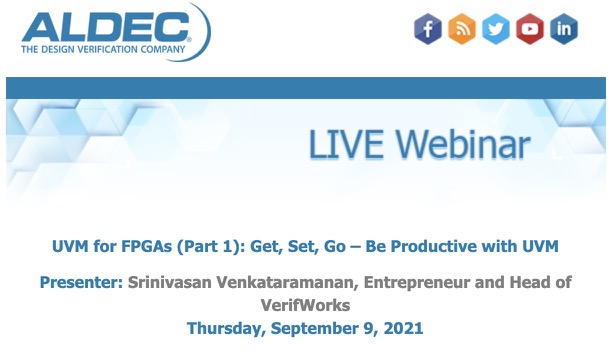
UVM for FPGAs (Part 1)
Presenter: Srinivasan Venkataramanan, Entrepreneur and Head of VerifWorks Thursday, September 9, 2021 Abstract: The Accelera Universal Verification Methodology (UVM) became an IEEE standard published as IEEE 1800.2 – IEEE Standard for UVM Language Reference Manual (LRM). UVM has been the predominant verification methodology for ASIC designs for many years and has recently gained popularity and… UVM for FPGAs (Part 1)
-
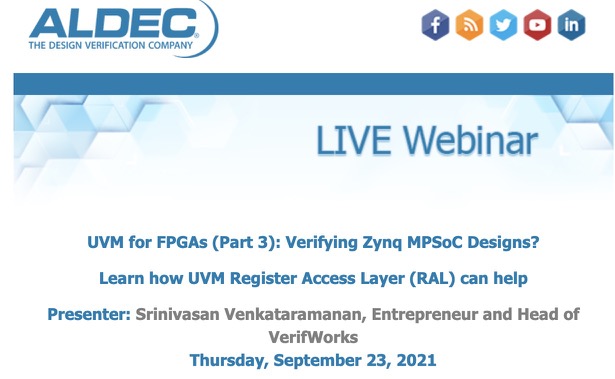
UVM for FPGAs (Part 3): Verifying Zynq MPSoC Designs?
Learn how UVM Register Access Layer (RAL) can help Presenter: Srinivasan Venkataramanan, Entrepreneur and Head of VerifWorks Thursday, September 23, 2021 Abstract: The use of highly configurable IP-based designs have become the norm in the SoC era. Modern SoC designs targeting Xilinx® Zynq Ultrascale+ MPSoC include an extensive list of standard embedded IPs and custom… UVM for FPGAs (Part 3): Verifying Zynq MPSoC Designs?
-
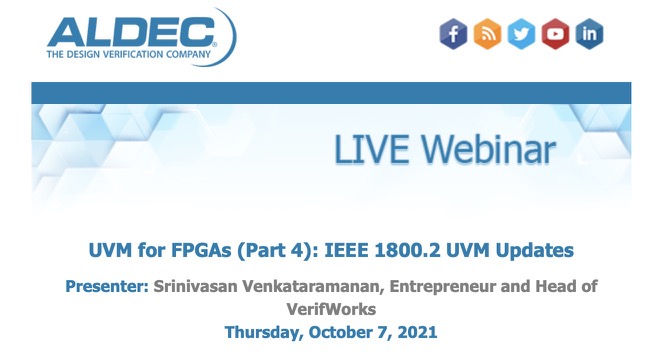
UVM for FPGAs (Part 4): IEEE 1800.2 UVM Updates
Abstract: Started with an early adaptor release as Accellera 1.0a, UVM has evolved into few significant versions including UVM 1.1 and UVM 1.2. As with many popular useful standards, UVM has attained the coveted IEEE standardization in 2017. Interestingly, UVM is the first verification methodology to be standardized, and the current version is IEEE 1800.2-2020.… UVM for FPGAs (Part 4): IEEE 1800.2 UVM Updates
-
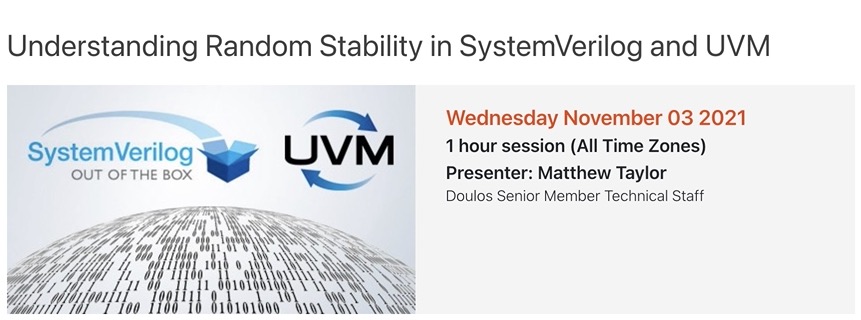
Understanding Random Stability in SystemVerilog and UVM
Webinar Overview: A common issue with constrained random simulation is being able to reproduce random stimulus for debug purposes and for locking down regressions test suites. This is especially problematic when the source code needs to be modified and is known in SystemVerilog as random stability. In this webinar, we explain: Random stability in SystemVerilog… Understanding Random Stability in SystemVerilog and UVM
-
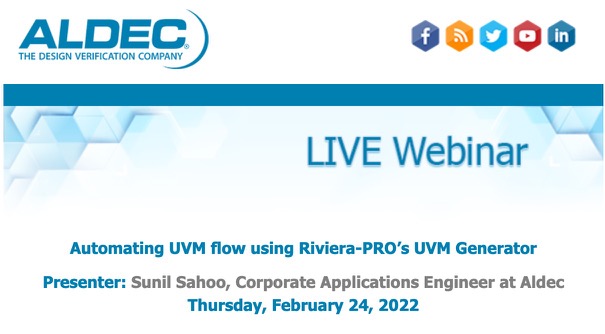
Automating UVM flow using Riviera-PRO’s UVM Generator
UVM is a versatile verification methodology that enables users to run advanced verification flows for large scale FPGAs and SoC FPGAs. However, because of its advanced nature, writing UVM from scratch can be a complex and tedious task. Riviera-PRO’s new UVM Generator feature alleviates some of the complexity by automatically creating the UVM testbench for… Automating UVM flow using Riviera-PRO’s UVM Generator
-

An Easy Solution for Automated Register Verification
Learn how to stress-test your registers in simulation by automatically generating your entire UVM testbench and supporting Makefiles for complete register verification using ARV-Sim™.
-

Debugging Features of UVM
A UVM testbench is a large and complex piece of software. At some stage, like any other large and complex piece of software, a verification environment written using UVM is going to require debugging. There are various debugging features built into UVM to help with this. In this webinar, Doulos Senior Member Technical Staff, Doug… Debugging Features of UVM
-
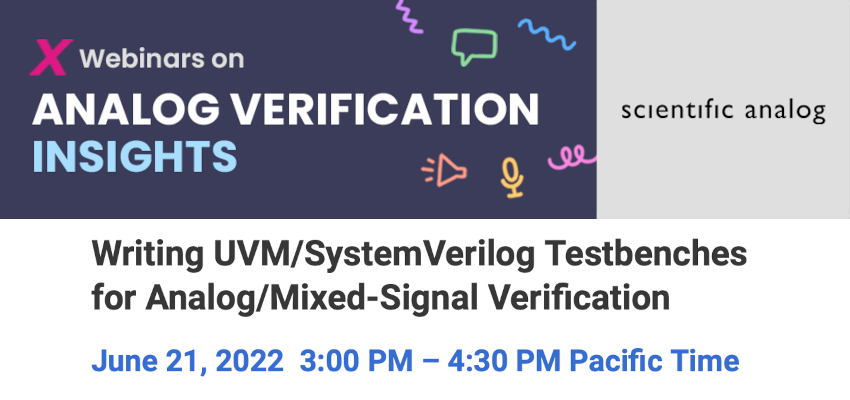
Writing UVM/SystemVerilog Testbenches for Analog/Mixed-Signal Verification
Learn how to write UVM testbenches for analog/mixed-signal circuits. UVM (Universal Verification Methodology) is a framework of standardized SystemVerilog classes to build reusable and scalable testbenches for digital designs, and it can be extended to verifying analog circuits simply by using a fixture module that generates analog stimuli and measures analog responses with Scientific Analog's… Writing UVM/SystemVerilog Testbenches for Analog/Mixed-Signal Verification
-

Centralized Register Design and Verification from a Golden Specification
Learn how to bring the ease of a document editor to your system architects and designers to create an executable specification using IDesignSpec™. This specification fully describes and documents your design and automatically generates all downstream views. IDesignSpec™ enables IP, SoC, and FPGA teams to standardize on your register specification and generate Verilog, VHDL, UVM, C… Centralized Register Design and Verification from a Golden Specification
-
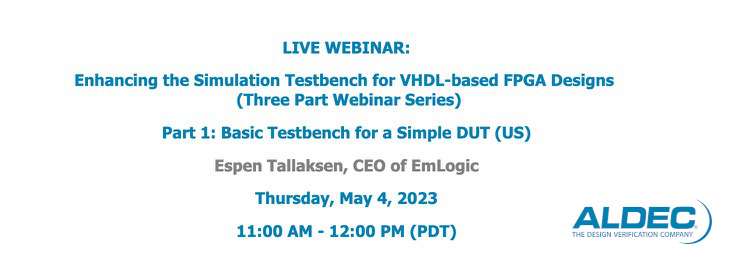
Basic Testbench for a Simple DUT
Presenter: Espen Tallaksen, CEO of EmLogic Abstract Part 1: Functional simulation using an HDL testbench is the de facto method for proving functional correctness of FPGA designs. In this three-part webinar series we will present a step-by-step approach on how to architect a testbench - progressing from basic to advanced techniques. We will first use… Basic Testbench for a Simple DUT
-
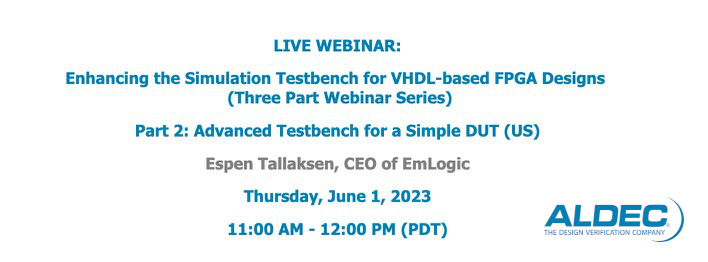
Advanced Testbench for a Simple DUT
Abstract: Functional simulation using an HDL testbench is the de facto method for proving functional correctness of FPGA designs. In this three-part webinar series, we will present a step-by-step approach on how to architect a testbench - progressing from basic to advanced techniques. We will first use a simple DUT then go to a more… Advanced Testbench for a Simple DUT
-

Verification Futures 2023 UK
University of Reading Whiteknights Campus Park House, Reading, United KingdomThe Verification Futures conference provides a unique blend of conference presentations, exhibitions, training and industry networking sessions dedicated to discussing the challenges faced in hardware and software verification. Verification Futures provides a unique opportunity for end-users to define their current and future verification challenges and collaborate with the vendors to create solutions. It also provides… Verification Futures 2023 UK